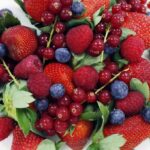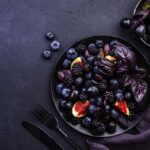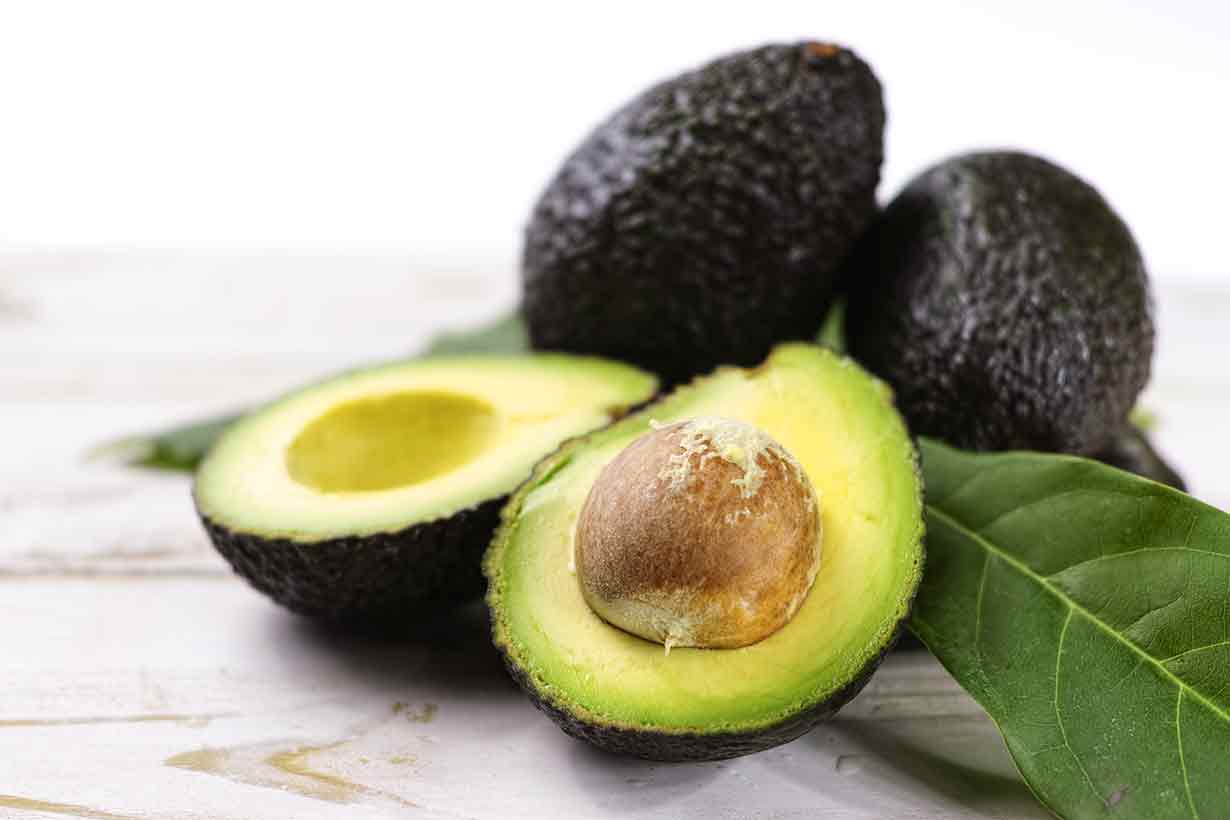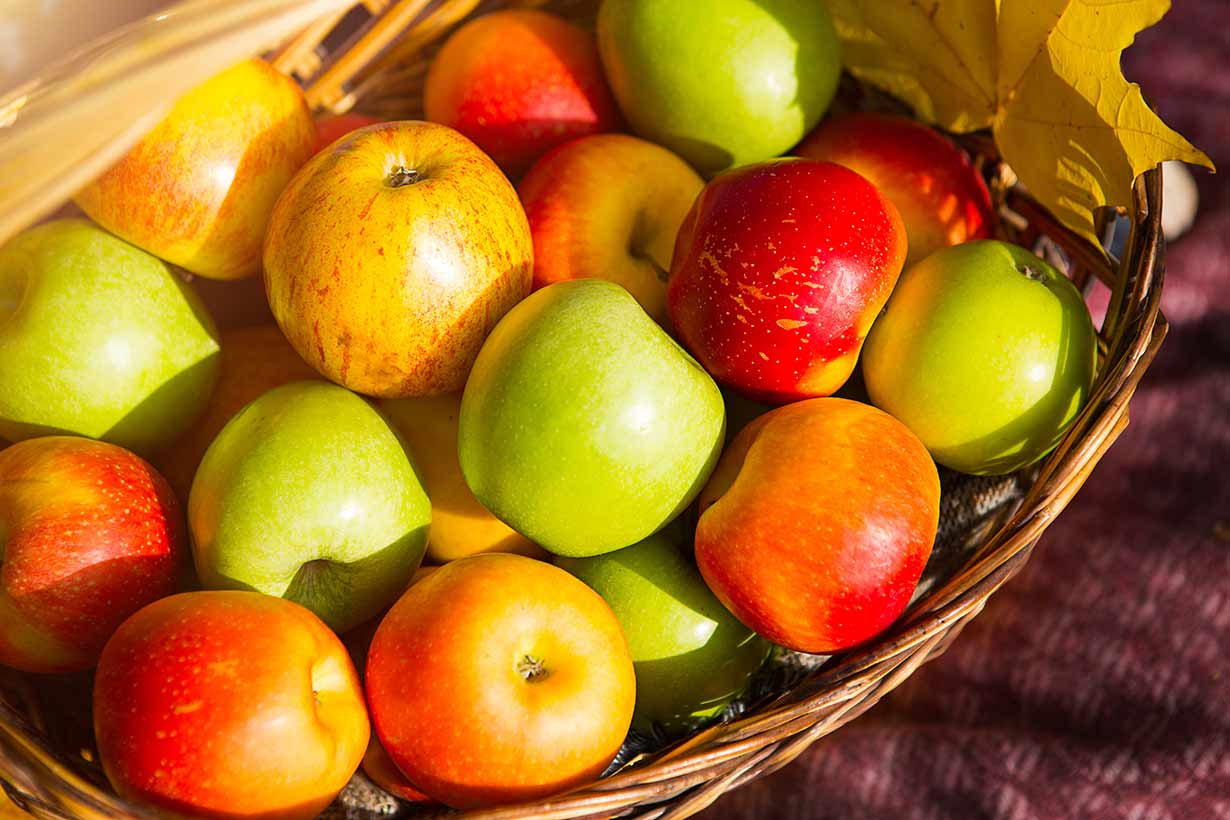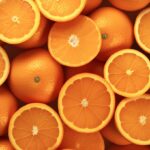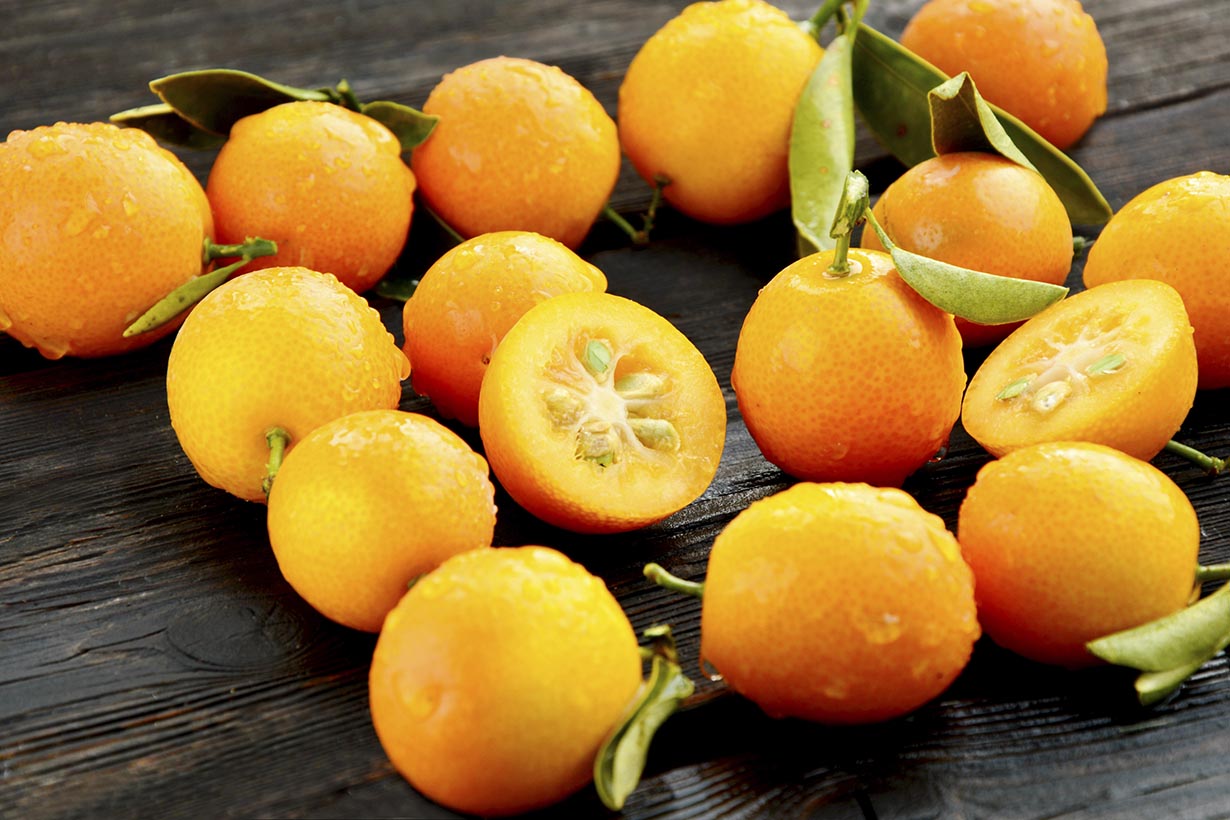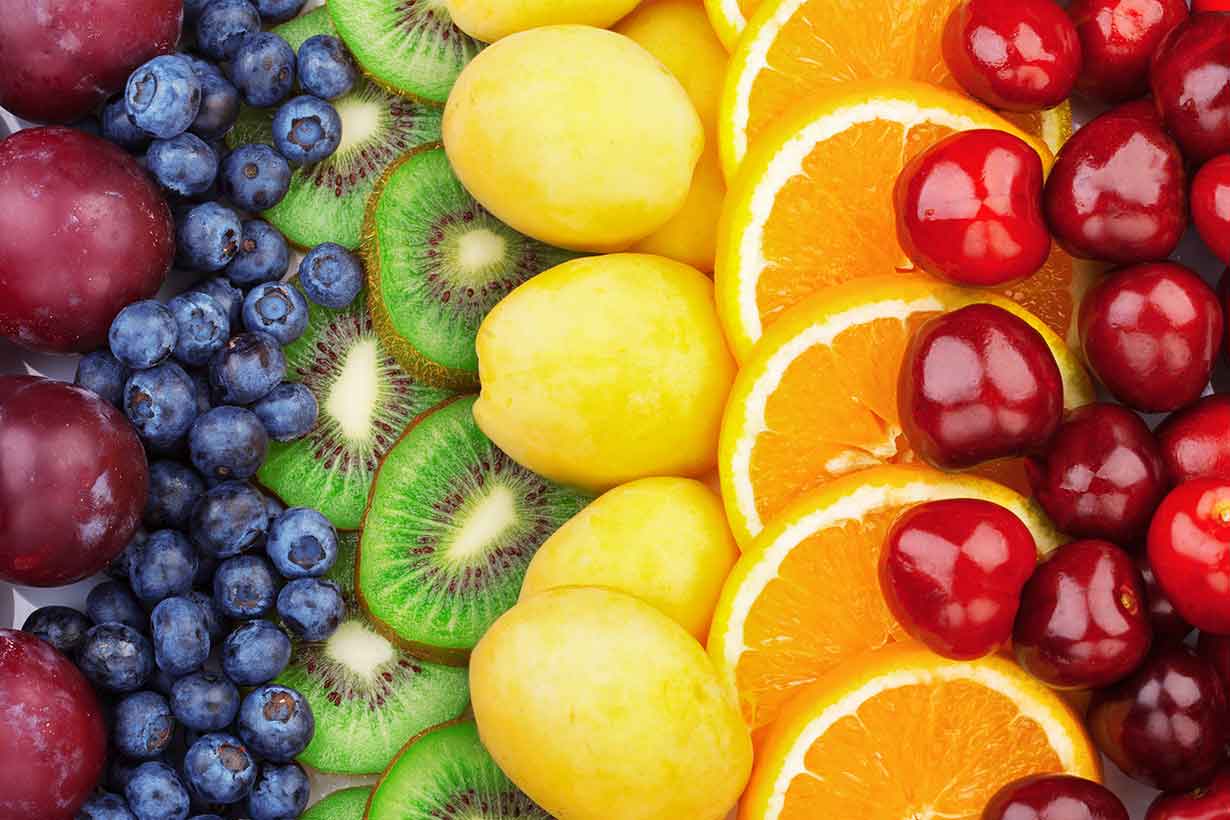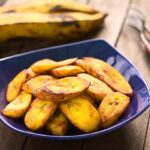There are many different varieties of fruit, each with its own distinct color.
This article will focus on the various yellow fruits that are available.
Do yellow fruits offer any unique nutritional benefits?
This article lists common yellow fruit options and examines their nutritional properties.
Table of contents
What fruits are yellow and what gives them their color?
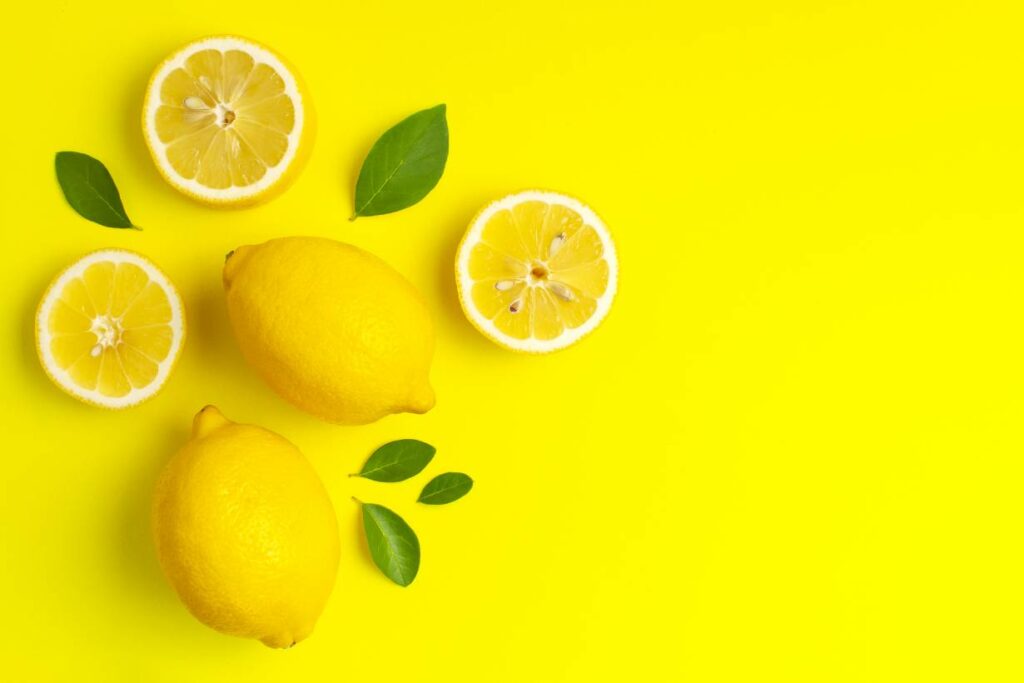
There are various yellow fruit varieties that grow worldwide.
Some of the most common of these include bananas and mangos. Notably, these fruits obtain their yellow pigment from the compounds they contain.
For example, specific carotenoids, such as beta-carotene, give mangos their yellow flesh (1)
Additionally, betaxanthin, a type of betalain, can also give fruits a yellow color. Betalains are nitrogen-containing pigments found within certain plants (2).
Do yellow fruits provide unique nutritional benefits?
First, a specific fruit’s color does not dictate its nutrition and health properties.
In this regard, different fruit colors contain varying compounds, which may all offer some benefits.
For instance, purple fruits and red fruits are often a rich source of anthocyanins.
That said, carotenoids and betaxanthins do offer their own potential benefits. Thus, fruits that contain these compounds may provide those specific benefits over fruit options that do not.
On this note, research demonstrates that carotenoids hold importance for vision and may have benefits for protecting against oxidative stress, diseases of aging, and cognitive impairment (3, 4, 5).
Less is known about betaxanthins, but they have antioxidant properties and may also provide health benefits (6, 7).
Aside from their pigment, many yellow fruits provide high levels of vitamin C. This essential vitamin plays a vital role in immune health and protecting against free radical-induced damage (8).
A list of yellow fruits
Here, listed in alphabetical order, are some of the most commonly available yellow fruit options.
All daily values (% DV) have been calculated using USDA data and the FDA’s published daily values.
1) Apricot
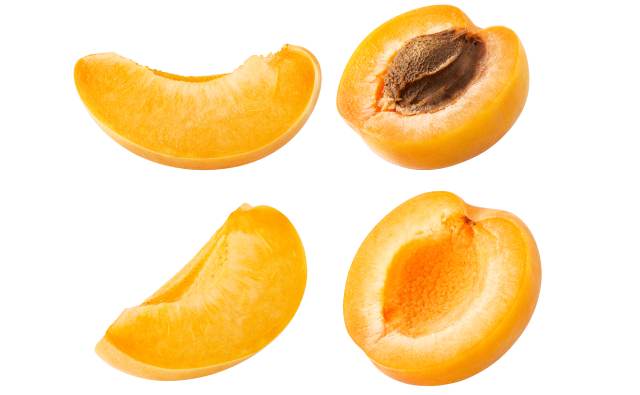
Apricots are a common summer fruit with a mild yellow to light orange color.
As well as being a popular fresh fruit, they are also available as dried apricots.
The yellow pigment of apricots comes from their carotenoid content, which includes beta-carotene, beta-cryptoxanthin, and gamma-carotene (9).
Apricots are primarily a source of vitamin C regarding their micronutrient content (10).
Key facts (per 35-gram apricot)
- Calories: 17 kcal
- Carbohydrates: 3.88 g
- Fiber: 0.7 g
- Sugars: 3.23 g
- Fat: 0.14 g
- Protein: 0.49 g
- Key nutrients: Vitamin C (4% DV), vitamin A (4% DV)
2) Bananas
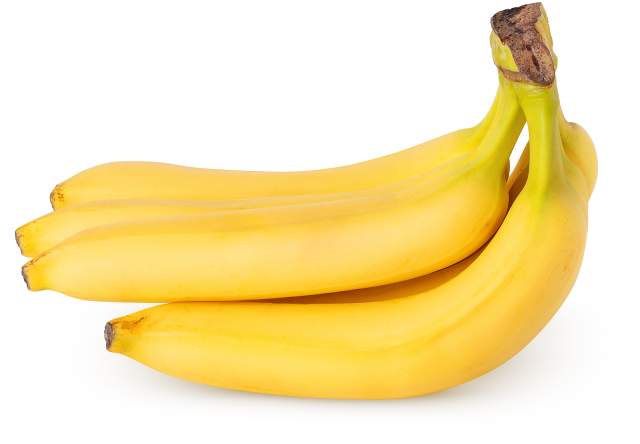
Bananas are one of the most popular fruits in the world.
A typical banana has creamy yellow flesh and a green-to-yellow peel, depending on how ripe the fruit is.
Research shows that the yellow color of bananas comes from beta-carotene (11).
Concerning their nutritional values, bananas are a good source of potassium. They also provide high levels of vitamin B6 and vitamin C (12).
Key facts (per 118-gram banana)
- Calories: 105 kcal
- Carbohydrates: 26.9 g
- Fiber: 3.07 g
- Sugars: 14.4 g
- Fat: 0.389 g
- Protein: 1.29 g
- Key nutrients: Vitamin C (11% DV), vitamin B6 (25% DV), potassium (9.0% DV)
3) Cape Gooseberries
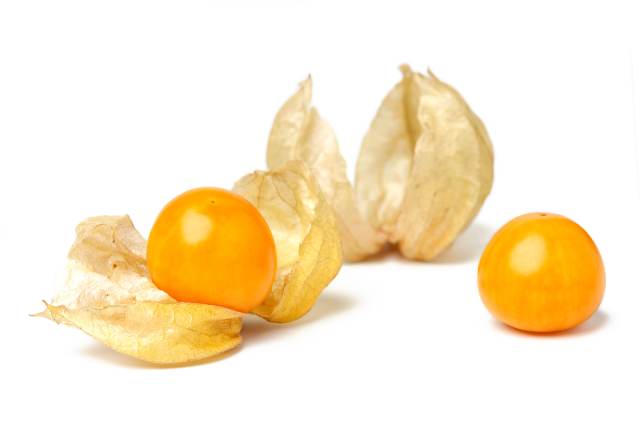
Cape gooseberries (also known as Peruvian groundcherries) are small round berries with a yellow to orange color.
The yellow pigmentation of cape gooseberries comes from their high carotenoid content.
Several carotenoids have been identified in the berries, including trans-lutein, beta-cryptoxanthin, alpha-carotene, and beta-carotene (13).
Cape gooseberries also have a good micronutrient profile, with high levels of vitamin C and niacin (14).
Key facts (per 140-gram cup)
- Calories: 74 kcal
- Carbohydrates: 15.7 g
- Fat: 0.98 g
- Protein: 2.66 g
- Key nutrients: Niacin (25% DV), Vitamin C (17% DV)
4) Durian
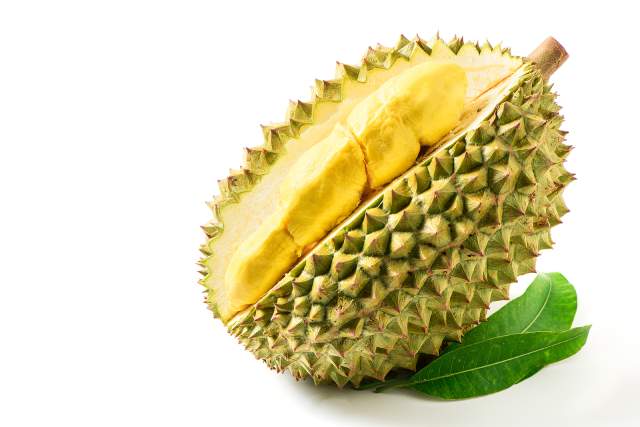
Durian is a large tropical fruit with a spiky green peel surrounding an inner yellow flesh.
The yellow pigmentation of durian comes from its high carotenoid content, primarily beta-carotene and alpha-carotene (15).
Durian provides high levels of several nutrients, with particularly large amounts of vitamin C, thiamin, and manganese (16).
Key facts (per 100-gram serving)
- Calories: 147 kcal
- Carbohydrates: 27.1 g
- Fiber: 3.80 g
- Fat: 5.33 g
- Protein: 1.47 g
- Key nutrients: Thiamin (31% DV), vitamin C (21% DV), manganese (14% DV)
5) Egg Fruit
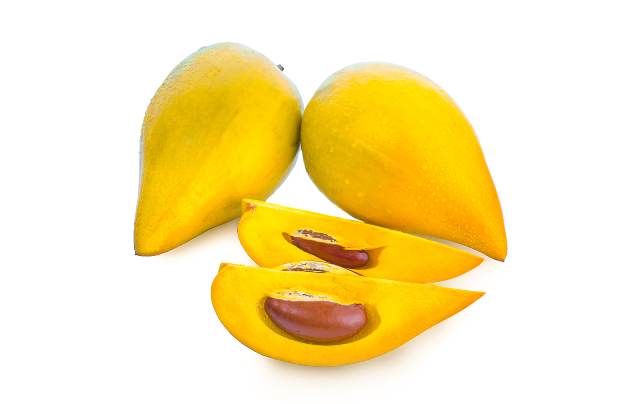
Also known as canistel, egg fruit has a unique avocado-like appearance but with yellow flesh rather than green.
Egg fruit gets its yellow pigmentation from its carotenoid content, and it is an especially good source of a carotenoid called zeaxanthin (17).
Egg fruit is a rich source of vitamin C and provides good amounts of thiamin and niacin (18).
Key facts (per 100-gram serving)
- Calories: 139 kcal
- Carbohydrates: 36.69 g
- Fiber: 0.10 g
- Fat: 0.13 g
- Protein: 1.68 g
- Key nutrients: Vitamin C (65% DV), niacin (23% DV), thiamin (14% DV)
6) Jackfruit
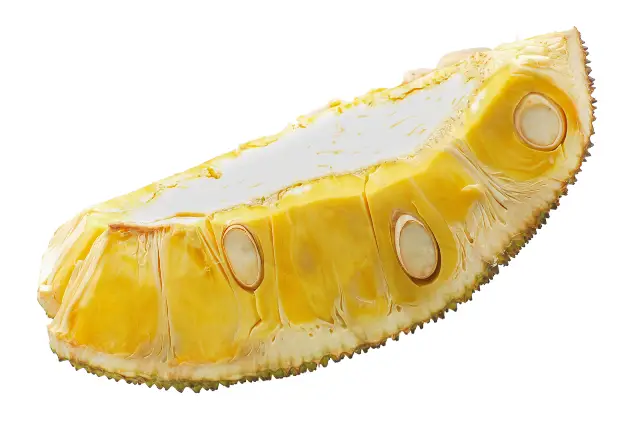
Jackfruit shares some resemblance with durian in terms of appearance.
This large fruit has soft yellow flesh surrounded by a hard outer green shell.
The yellow flesh of the jackfruit is due to its high levels of carotenoids, which include all-trans-lutein, all-trans-beta-carotene, all-trans-neoxanthin, 9-cis-neoxanthin, and 9-cis-violaxanthin (19).
Nutritionally, jackfruit offers a rich source of potassium, vitamin C, and vitamin B6 (20).
Key facts (per 151-gram cup)
- Calories: 143 kcal
- Carbohydrates: 35.0 g
- Fiber: 2.26 g
- Fat: 0.97 g
- Protein: 2.6 g
- Key nutrients: vitamin C (23% DV), vitamin B6 (29% DV), potassium (16% DV)
7) Lemon
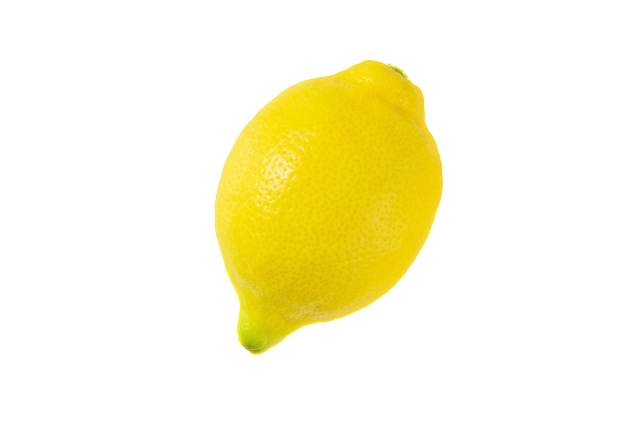
Lemons are one of the most common fruits on supermarket shelves. The fruit has a mild yellow flesh surrounded by bright yellow skin.
Once again, a range of carotenoids is behind the yellow pigmentation of lemons (21, 22).
Regarding their vitamin and mineral content, lemons are primarily a source of vitamin C (23).
Key facts (per 65-gram lemon)
- Calories: 19 kcal
- Carbohydrates: 6.06 g
- Fiber: 1.82 g
- Sugars: 1.62 g
- Fat: 0.20 g
- Protein: 0.72 g
- Key nutrients: vitamin C (38% DV)
8) Loquat
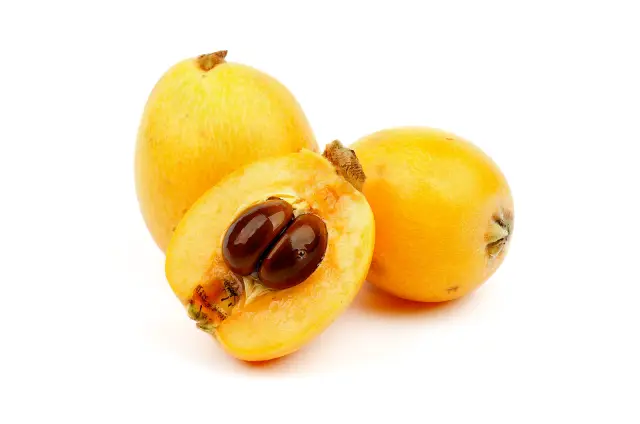
Loquat is a small oval-shaped drupe (stone) fruit with a golden yellow color.
The loquat’s yellow pigmentation comes from its content of carotenoids, including beta-carotene, zeta-carotene, neurosporene, beta-cryptoxanthin, violaxanthin, and auroxanthin (24, 25).
Manganese and potassium are the primary micronutrients that loquats provide (26).
Key facts (per 149-gram cup)
- Calories: 70 kcal
- Carbohydrates: 18.0 g
- Fiber: 2.53 g
- Fat: 0.30 g
- Protein: 0.64 g
- Key nutrients: Manganese (10% DV), potassium (8% DV)
9) Mango
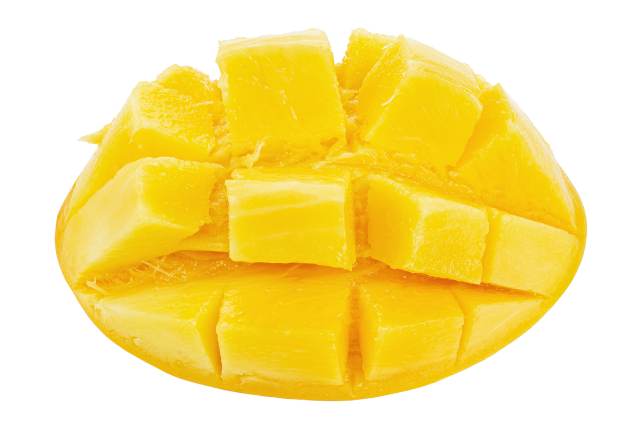
Mango is one of the world’s most popular fruits, and it has a bright yellow flesh surrounded by peel that can range from yellow to green and red.
The yellow pigmentation of mango is due to carotenoids, with the fruit primarily containing beta-carotene, lutein, and zeaxanthin (27).
Mango supplies a wide range of micronutrients but has particularly high amounts of folate and vitamin C (28).
Key facts (per 165-gram cup)
- Calories: 99 kcal
- Carbohydrates: 24.8 g
- Fiber: 2.64 g
- Sugars: 22.6 g
- Fat: 0.63 g
- Protein: 1.35 g
- Key nutrients: Vitamin C (67% DV), folate (18% DV)
10) Nectarine
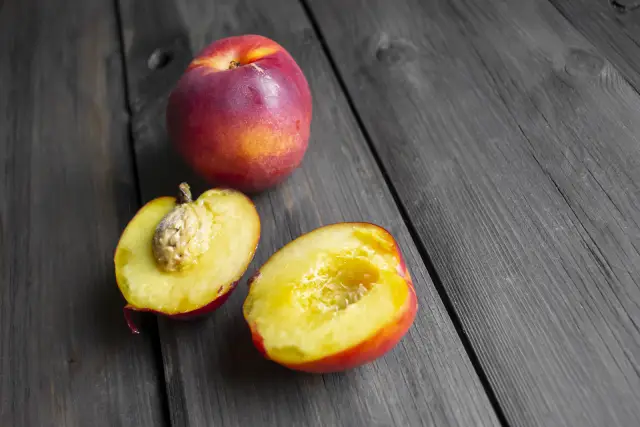
Nectarines typically have a red and yellow skin color with yellow flesh.
However, there are also white-fleshed nectarines available.
The difference between the pigments of these two nectarine cultivars is their total carotenoid content.
For example, research has found that yellow-flesh nectarines had a total carotenoid content of 80-186 mcg per 100 grams. In contrast, white-flesh nectarines only contained 7-14 mcg of carotenoids (29).
The primary vitamins and minerals in nectarines are niacin, potassium, and vitamin C (30).
Key facts (per 142-gram ‘medium’ nectarine)
- Calories: 63 kcal
- Carbohydrates: 15.1 g
- Fiber: 2.41 g
- Sugars: 11.2 g
- Fat: 0.45 g
- Protein: 1.5 g
- Key nutrients: Niacin (10% DV), potassium (6% DV), vitamin C (9% DV)
11) Papaya
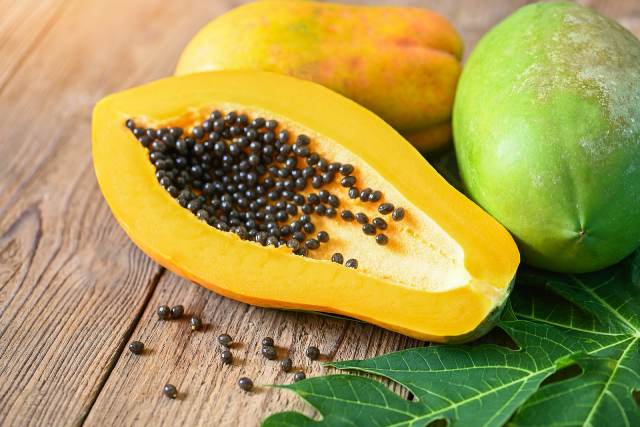
Similar to mango, papaya is a tropical fruit that can have yellow to orange-red flesh surrounded by green peel.
The main difference between the yellow-fleshed and orange-red-fleshed papaya is the type of carotenoids they contain.
For instance, the primary carotenoids in yellow-fleshed papaya are beta-carotene and beta-cryptoxanthin. However, the primary carotenoid in red-fleshed papaya is lycopene (31).
Papayas are good sources of vitamins and minerals, especially folate and vitamin C (32).
Key facts (per 145-gram cup)
- Calories: 62 kcal
- Carbohydrates: 15.7 g
- Fiber: 2.46 g
- Sugars: 11.3 g
- Fat: 0.38 g
- Protein: 0.68 g
- Key nutrients: Vitamin C (98% DV), folate (13% DV)
12) Peach
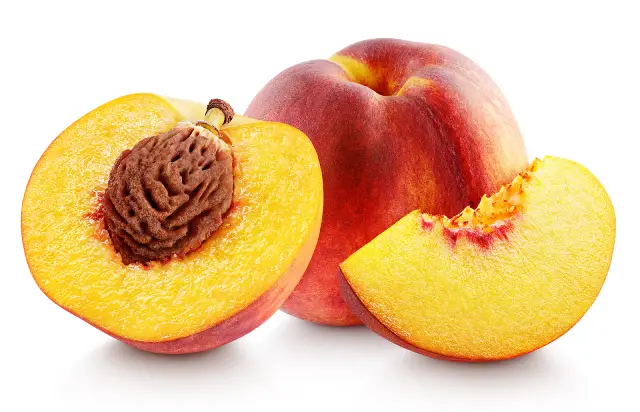
Peaches are very similar to nectarines, with one of the only differences being they have furry skin. This being the case, peaches have red-yellow skin and yellow flesh.
The yellow pigmentation is down to the high carotenoid content of peaches (29).
Nutritionally, peaches are a good source of vitamin C and potassium (33).
Key facts (per 150-gram peach)
- Calories: 69 kcal
- Carbohydrates: 15.2 g
- Fiber: 2.25 g
- Sugars: 12.6 g
- Fat: 0.41 g
- Protein: 1.36 g
- Key nutrients: Vitamin C (7% DV), potassium (4% DV)
13) Pineapple
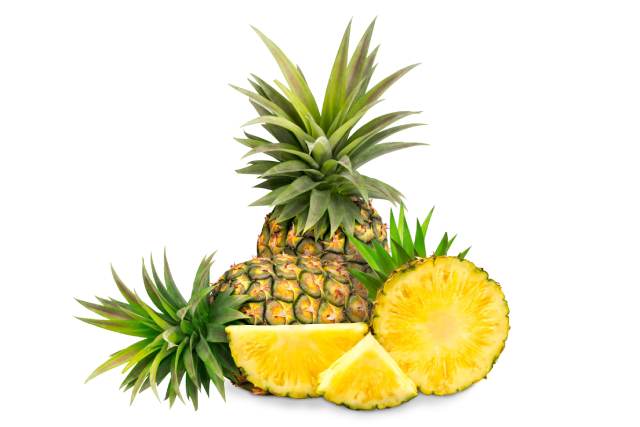
Pineapple is a moderately large fruit with yellow flesh surrounded by thick, spiky skin.
This yellow pigmentation of pineapple comes from its carotenoid content, which includes beta-carotene, lutein, violaxanthin, and xanthophyll (34, 35).
Concerning the nutritional profile of pineapple, the fruit contains good levels of a range of vitamins and minerals. Pineapple offers high amounts of vitamin C, manganese, and copper (36).
Key facts (per 165-gram cup)
- Calories: 83 kcal
- Carbohydrates: 21.6 g
- Fiber: 2.31 g
- Sugars: 16.3 g
- Fat: 0.20 g
- Protein: 0.89 g
- Key nutrients: Vitamin C (88% DV), manganese (67% DV), copper (20% DV)
14) Plantain
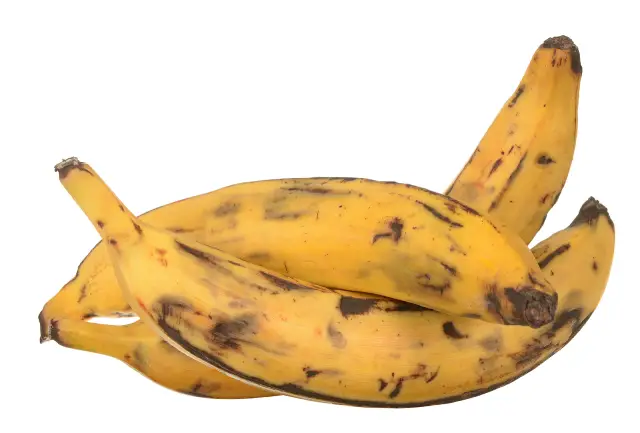
Plantains have a very similar appearance to bananas but have a different flavor, size, and texture.
Like bananas, the plantain has a cream-to-yellow flesh and a green-yellow peel, depending on ripeness.
Like bananas, the yellow pigment comes from carotenoids, primarily beta-carotene (37).
Plantains offer good nutritional value and provide high potassium, vitamin C, and vitamin K content (38).
Key facts (per 139-gram cup)
- Calories: 215 kcal
- Carbohydrates: 57.5 g
- Fiber: 3.06 g
- Sugars: 29.6 g
- Fat: 0.22 g
- Protein: 2.11 g
- Key nutrients: Potassium (14% DV), vitamin C (25% DV), vitamin K (15% DV)
15) Quince
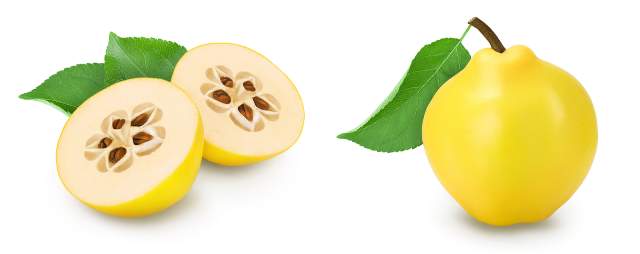
Once ripe, quince has bright yellow skin that surrounds a creamy white flesh.
The strong yellow pigmentation of quince skin comes from the fruit’s high carotenoid content, primarily beta-carotene (39).
Nutritionally, quince provides moderate vitamin C and copper (40).
Key facts (per 92-gram fruit)
- Calories: 52 kcal
- Carbohydrates: 14.1 g
- Fiber: 1.75 g
- Fat: 0.09 g
- Protein: 0.37 g
- Key nutrients: Vitamin C (15% DV), copper (13% DV)
16) Starfruit
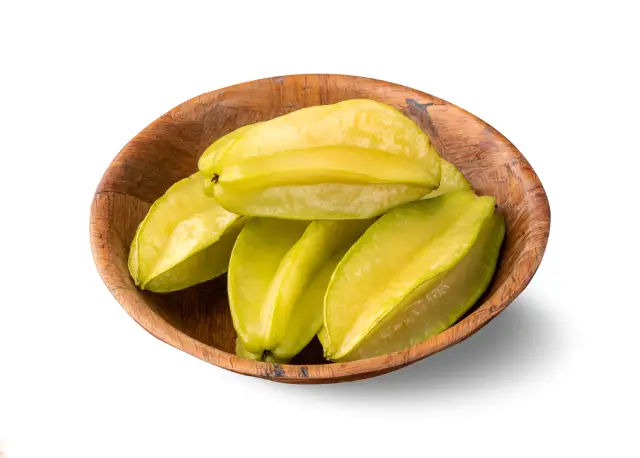
Starfruit is a tropical fruit with yellow flesh and yellow skin when ripe.
The yellow pigment of starfruit primarily comes from the carotenoids beta-carotene and cryptoxanthin (41, 42).
Starfruit is green when not fully ripe due to large amounts of chlorophyll, which deplete as the fruit ripens (42).
Nutritionally, starfruit is an excellent source of vitamin C, and it also provides a moderate amount of copper (43).
Key facts (per 91-gram fruit)
- Calories: 28 kcal
- Carbohydrates: 6.12 g
- Fiber: 2.55 g
- Fat: 0.3 g
- Protein: 0.95 g
- Key nutrients: Vitamin C (35% DV), copper (14% DV)
Common Questions About Yellow Fruits
Lastly, here are some answers to common questions about yellow fruit varieties.
While this article has covered some of the most common yellow fruits, there are hundreds of different fruit varieties around the world. Some of these are relatively unknown, and some only grow in specific areas of the world. For these reasons, it is difficult to put an exact figure on the number of yellow fruit varieties.
Yellow fruits are neither “better” nor “worse” than other fruit options. To consume a broader range of different nutrients and phytochemicals, eating a variety of fruit and vegetables of different colors is a good idea.
Final Thoughts
There are many kinds of yellow fruit, and they all offer good nutritional value.
However, it is a good idea to vary the types of fruit we eat to ingest a greater variety of different nutrients and compounds.
For instance, yellow fruits may offer a variety of carotenoids, but purple fruits provide more anthocyanins and other polyphenols.

